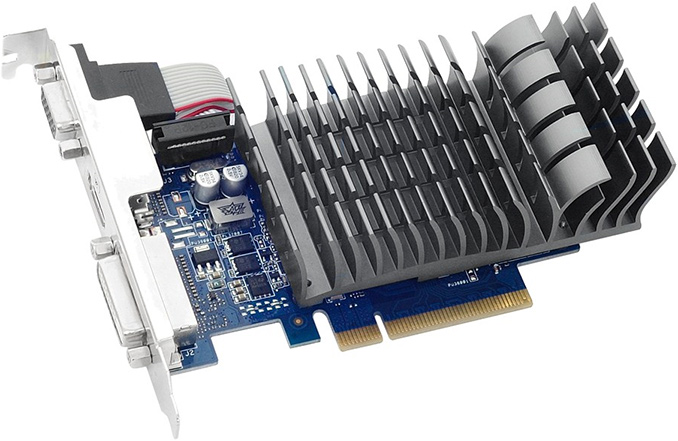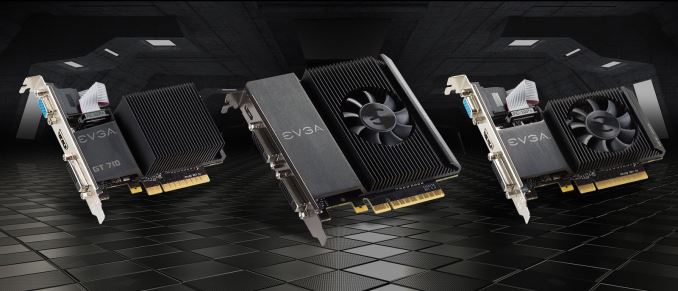NVIDIA’s Partners Roll-Out GeForce GT 710 to Fight Integrated Graphics
by Anton Shilov on January 27, 2016 1:07 PM EST
Advancements made by iGPUs by AMD and Intel in the recent years essentially destroyed the market of inexpensive discrete video cards. High-performance iGPUs can outperform low-end standalone graphics adapters these days and for a lot of users performance of integrated graphics is enough. Nonetheless, there's still a smaller market for low-end add-in boards - notably as upgrades to true entry-level PCs - and to that end NVIDIA’s partners this week released a new breed of low-end graphics cards targeting entry-level PCs.
The new NVIDIA GeForce GT 710 video cards are based on a cut-down version of the company's existing GK208 GPU, with 192 stream processors, 16 texture units and 8 ROPs. As this is a Kepler architecture product, you'll find baseline support for Direct3D feature level 11_0 but not newer features found in the Maxwell generation such as HDMI 2.0, which is likely why NVIDIA opted to launch this as a 700 series product. Peak compute performance of the GPU when clocked at 954 MHz is around 366 GFLOPS, which is below that of contemporary higher-end iGPUs by Intel or AMD. The GeForce GT 710 graphics cards are equipped with 1 or 2 GB or DDR3-1800 memory featuring 14.4 GB/s bandwidth.
| NVIDIA GPU Specification Comparison | ||||||
| GT 710 | GT 720 | GT 630 | GT 610 | |||
| CUDA Cores | 192 | 192 | 192 | 48 | ||
| Texture Units | 16 | 16 | 16 | 8 | ||
| ROPs | 8 | 8 | 16 | 4 | ||
| Core Clock | 954MHz | 797MHz | 875MHz | 710MHz | ||
| Shader Clock | N/A | N/A | N/A | 1620MHz | ||
| Memory Clock | 1.8GHz DDR3 | 1.8GHz DDR3/ 5GHz GDDR5 | 1.8GHz DDR3 | 1.8GHz DDR3 | ||
| Memory Bus Width | 64-bit | 64-bit | 64-bit | 64-bit | ||
| VRAM | 1GB or 2GB | 1GB or 2GB | 1GB or 2GB | 1GB | ||
| TDP | 19W | 19W | 50W | 29W | ||
| GPU | GK208 | GK208 | GK107 | GF119 | ||
| Launch Timeframe | January, 2016 | March, 2014 | April, 2012 | May, 2012 | ||
| Launch Price | $30 - $50 | $49 | OEM | $49 | ||
Makers of graphics cards position their NVIDIA GeForce GT 710 boards as solutions for entry-level PCs running Intel Celeron or Intel Pentium processors with mediocre iGPUs, and these are typically the comparisons you'llsee vendors make as it doesn't take much to surpass low-end iGPUs. That said, while the GeForce GT 710 can indeed be considerably faster than outdated integrated GPUs, it is unlikely that it can enable decent performance in demanding video games, and this is more likely to be pitched as a card for MOBAs and similar low-impact games.
From a sales perspective, since the GK208 GPU is not a new graphics chip - having been launched back in 2013 - it is somewhat surprising to see that virtually all partners of NVIDIA decided to release their new video cards powered by the GPU. The market for such adapters is very limited these days because 100% of entry-level PCs use iGPUs. Moreover, even in countries like China, where inexpensive hardware is sold in large quantities, more and more gamers are adopting higher-end discrete video cards, according to media reports.
Meanwhile from a technical perspective, as the GeForce GTX 710 are designed for low-end PCs, many of such video cards come in half-height/half-length form-factor. Typical for low-end cards (especially those expected to sell well in the APAC market), all of the GT 710s we've seen so far feature D-Sub analogue monitor output for compatibility with older monitors, along with the more typical DVI and/or HDMI/DP connectors. Meanwhile GT 710 is rated for a TDP of just 20 W, so many of the cards use passive cooling solutions, while the rest feature small fans.
The NVIDIA GeForce GT 710 graphics cards are available from companies like ASUS, EVGA, Galax, Gigabyte, Inno3D, Palit Multimedia, Manli, MSI, ZOTAC and some others. Prices of the GeForce GT 710-based graphics adapters vary, but typically such cards cost from $30 to $50 in the U.S.











60 Comments
View All Comments
benzosaurus - Thursday, January 28, 2016 - link
The awkward moment when Nvidia releases new desktop cards that are slower than their current-gen tablet SOCs.stardude82 - Thursday, January 28, 2016 - link
Hey, I might buy a couple. These should slot around the HD 4670/GT 240 performance tier and will play Source based games (L4D, DotA2) and Minecraft just fine. As AMD is axing W10 drivers for legacy cards, I might be in the market.yannigr2 - Thursday, January 28, 2016 - link
GT 240 Memory Bandwidth 28.8 GB/sec or 54.4 GB/secHD 4670 Memory Bandwidth 32 GB/sec or 27.94 GB/sec
GT 710 Memory Bandwidth 14.4GB/sec BEST case scenario.
GT 240 and HD 4670 will be totally destroying GT 710 in every 3D benchmark/game there is out there. ALWAYS check the available bandwidth first, then check the number of cores and everything else. With a bandwidth of only 14.4GB/sec or even lower, GT 710 is going to be 2-3 times slower than those cards you mention in 3D games. If it had at least 30-40GB/sec it could perform better than those two old cards, but that 14.4GB/sec is a HUGE bottleneck.
Klimax - Thursday, January 28, 2016 - link
Will they? You are awfully certain about untested part. You are abusing one set of numbers and ignoring rest. (As if we haven't learned that with other cases like Kepler/GCN comparison) Since there is no evidence or data to back your assertions up, this post is nothing more then baseless supposition.MrMilli - Thursday, January 28, 2016 - link
LOLyannigr2 - Thursday, January 28, 2016 - link
Yes they will. That bandwidth is very very low to have any 3D performance at all. I know it because I have a GT 620 (Fermi based 96 CUDA cores) and was comparing with an old 9800GT (112 cores if I remember correctly). 9800GT was many times faster than GT 620. At CUDA encoding,yes, GT 620 was better, but at Borderlands for example and 720p resolution where 9800GT was scoring 30fps, GT 620 at the same settings was producing a laughable slideshow.The bandwidth is very very low. With so limited bandwidth architecture differences or cuda core count is not the main factor.
xthetenth - Thursday, January 28, 2016 - link
Memory bandwidth is crucial, as shown by every review of AMD APUs that can't perform up to the specs of their GPU because of bandwidth limitations. It's a nice reliable upper bound and a good indicator of when the worst stuttering type problems will occur. It wouldn't be a superstar if it had HBM, but similarly that bandwidth is going to keep performance very low even if the chip were a Titan X OC.stardude82 - Thursday, January 28, 2016 - link
Thanks for that point. Then this is a horrible deal compared to the GT 730 which is still only a 25W part and can be had for $50.yannigr2 - Friday, January 29, 2016 - link
Be carefull with GT 730. There are three versions of GT 730.http://www.geforce.com/hardware/desktop-gpus/gefor...
One Kepler with 64bit GDDR5, one Kepler with 64bit DDR3 and one Fermi with 128bit DDR3. From those three, only the GDDR5 version can be considered a good option. With 40GB/sec bandwidth it can offer performance between a GT640 and a GTX650. The other two versions, especially that Kepler with the 64bit bus and DDR3, are not good options.
Buy only GDDDR5 cards.
If you buy a DDR3 card check first the memory bus and don't buy anything with a DDR3 and 64bit data bus combination. When comparing so low end cards buy always the one with the fastest RAM, NOT the more RAM. 4GB DDR3 at 1200MHz is much worst than 1GB DDR3 at 1800MHz.
stardude82 - Friday, January 29, 2016 - link
The Fermi version is garbage. A quarter of the cores and twice the heat.